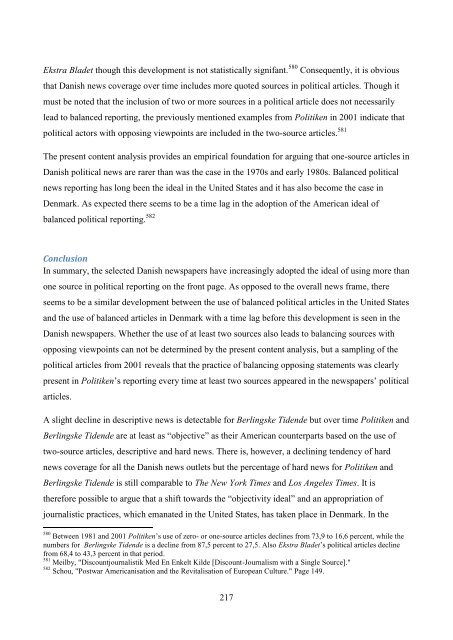The Jeremiad Over Journalism
The Jeremiad Over Journalism
The Jeremiad Over Journalism
Create successful ePaper yourself
Turn your PDF publications into a flip-book with our unique Google optimized e-Paper software.
Ekstra Bladet though this development is not statistically signifant. 580 Consequently, it is obvious<br />
that Danish news coverage over time includes more quoted sources in political articles. Though it<br />
must be noted that the inclusion of two or more sources in a political article does not necessarily<br />
lead to balanced reporting, the previously mentioned examples from Politiken in 2001 indicate that<br />
political actors with opposing viewpoints are included in the two-source articles. 581<br />
<strong>The</strong> present content analysis provides an empirical foundation for arguing that one-source articles in<br />
Danish political news are rarer than was the case in the 1970s and early 1980s. Balanced political<br />
news reporting has long been the ideal in the United States and it has also become the case in<br />
Denmark. As expected there seems to be a time lag in the adoption of the American ideal of<br />
balanced political reporting. 582<br />
Conclusion<br />
In summary, the selected Danish newspapers have increasingly adopted the ideal of using more than<br />
one source in political reporting on the front page. As opposed to the overall news frame, there<br />
seems to be a similar development between the use of balanced political articles in the United States<br />
and the use of balanced articles in Denmark with a time lag before this development is seen in the<br />
Danish newspapers. Whether the use of at least two sources also leads to balancing sources with<br />
opposing viewpoints can not be determined by the present content analysis, but a sampling of the<br />
political articles from 2001 reveals that the practice of balancing opposing statements was clearly<br />
present in Politiken‘s reporting every time at least two sources appeared in the newspapers‘ political<br />
articles.<br />
A slight decline in descriptive news is detectable for Berlingske Tidende but over time Politiken and<br />
Berlingske Tidende are at least as ―objective‖ as their American counterparts based on the use of<br />
two-source articles, descriptive and hard news. <strong>The</strong>re is, however, a declining tendency of hard<br />
news coverage for all the Danish news outlets but the percentage of hard news for Politiken and<br />
Berlingske Tidende is still comparable to <strong>The</strong> New York Times and Los Angeles Times. It is<br />
therefore possible to argue that a shift towards the ―objectivity ideal‖ and an appropriation of<br />
journalistic practices, which emanated in the United States, has taken place in Denmark. In the<br />
580 Between 1981 and 2001 Politiken‘s use of zero- or one-source articles declines from 73,9 to 16,6 percent, while the<br />
numbers for Berlingske Tidende is a decline from 87,5 percent to 27,5. Also Ekstra Bladet‘s political articles decline<br />
from 68,4 to 43,3 percent in that period.<br />
581 Meilby, "Discountjournalistik Med En Enkelt Kilde [Discount-<strong>Journalism</strong> with a Single Source]."<br />
582 Schou, "Postwar Americanisation and the Revitalisation of European Culture." Page 149.<br />
217
















